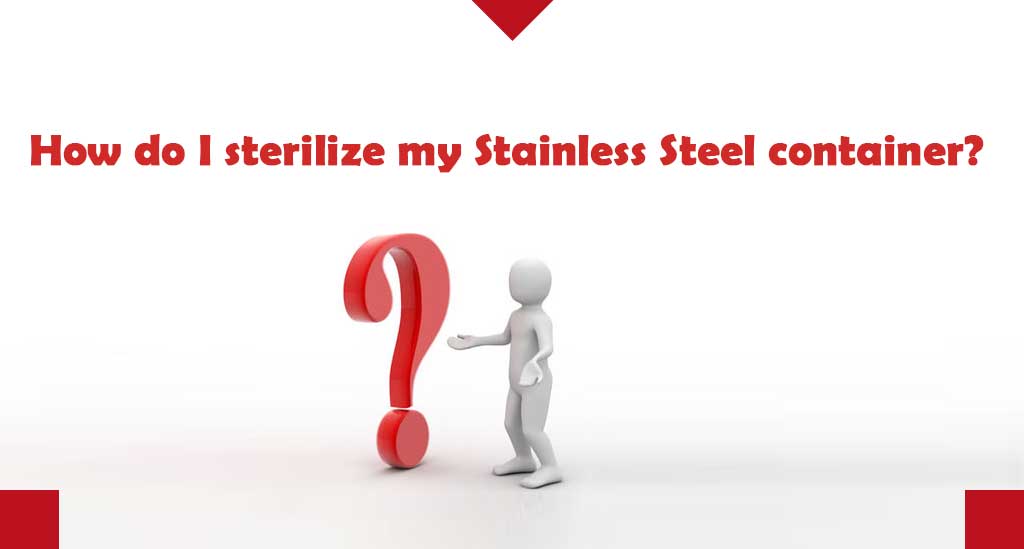
How do I sterilize my Stainless Steel container?
Now that you own a stainless steel container you may be wondering how you sterilize it. To find the answer to this question and others it is best to read the manual which came with your container and develop your own Standard Operating Procedures (SOP) that are compliant with your Good Manufacturing Practices (GMP) and HACCP procedures. The following article is a brief summary of what you need to understand when establishing your procedures. These are guidelines; your own procedures must override these, and it is critical that you have these SOPs to achieve your desired results and are written down and observed by those responsible for the containers.
Steaming and sterilization
The first step in sterilizing your stainless steel container is to clean it. The difference between clean and sterile is that a clean container has no residual or outside materials in it, while a sterile container goes a step further to ensure that there are no bacteria, mold, or other contaminates inside the container.
When doing a Clean in Place (CIP) system you must first open the container to ensure that it is not under pressure when you attempt to remove the lid. After the container is cleaned with a CIP ball or similar system you must close the container. At this time it is critical that the manway gasket, Pressure Relief Valve (PRV) and co2 valve are tight and functioning properly – without leaks. For a better understanding of this process please read additional articles in our blog. If you need to replace the parts on the containers, we recommend Original Equipment Manufacturer (OEM) parts which are available from Container-Parts.com.
Before steaming, the container must be closed with no leaks and a functional PRV.
The container is cleaned through the butterfly valve at the bottom of the container. Connect with a steam line and condensate gate through the butterfly valve. For this to be an effective aseptic cleaning system the connection must be sterile with the container not getting contaminated with outside air when the steam is disconnected.
In Europe the food processing industry has required a sterile filter under the co2 valve, and in some cases under the PRV, to ensure that the nitrogen going into the container is not contaminated (for details on this please read other articles in our blog). In some cases this sterile filter is replaced after each turn and in others it is tested to ensure that it is operating properly and replaced on average every eight turns.
In order to achieve sterilization, the manufacturer of CSC containers recommends 15-20 minutes steaming with min. 110-120°C (depending on pH of the product) Temperatures measured in the pipe after outlet of the steam, at the CO2/N2 valve on top of tote.
Pressurize with Nitrogen from the Top (CO2/N2 Valve), input to the pressure authorized on the leg plate of the container. Nitrogen is utilized because it is heavier than air, inert and available in sterilized condition. The weight of the nitrogen forces out lighter air out the PRV valve when the set pressure is achieved.
30 seconds after opening the nitrogen, close the steam valve to stop the steam process.
Cool the container down with freshwater shower. During the cooling a pressure equal to the PRV setting +/- an acceptable range shall remain as long as the valves are not opened.
The following example is for a PRV set at 1 bar, for specific details refer to your manual.
Reduce the nitrogen pressure to 0.7 – 0.9 bar.
When the tote is cooled to 40- 50°C and the nitrogen pressure is at 0,7-0,9 bar close the nitrogen valve. Remove the clutch.
Many top aseptic food manufactures utilize a foam pad soaked in alcohol 65% under a cap to protect the butterfly valve with protective cap.
Security: Quarantine – 24 hours at 0.5 bar. If the pressure is lower you have to check the seals and sterilize the tote a second time.
Warning – after a SIP the containers vulnerable to temperature changes. There are horror stories of customers placing a container that has just been cleaned outside in sub-zero temperatures and the vacuum created by this temperature change causes a vacuum in the container and the container will collapse like a beer can being crushed from end to end.
Options – if your product requires a vacuum CSC can provide you with a vacuum rated container to meet your needs.
 All Major Credit Cards Now Being Accepted. Charges may incur.
All Major Credit Cards Now Being Accepted. Charges may incur.